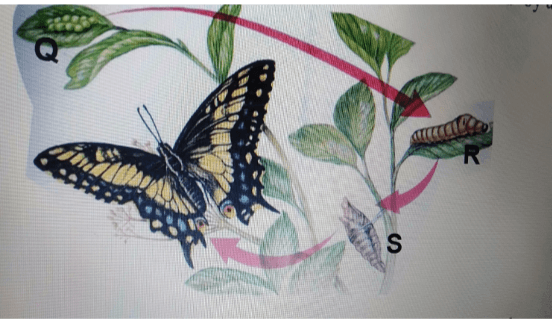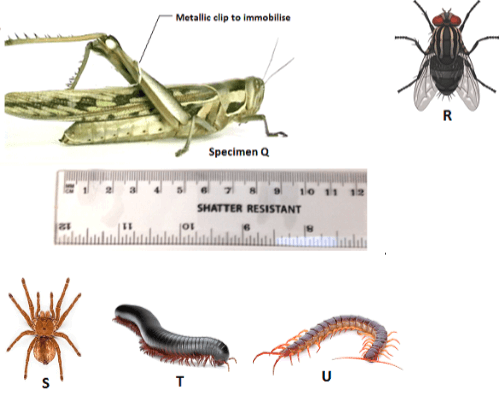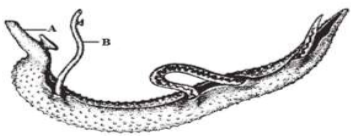- Answer ALL questions in in the spaces provided.
- You are required to spend the first 15 minutes of the 1¾ hours reading the whole paper carefully before commencing your work.
- Candidates should answer the questions in English
-
- You are provided with a specimen labelled Q. Slice off about 2cm2 cube from the specimen. Peel it. Tie one end of the 8cm LONG transparent visking tubing provided. Place the cube and tie the other end to ENSURE THERE IS NO LEAKAGE AT BOTH ENDS OF THE TUBING.
Rinse the outside of the tubing with water. Immerse the tubing with its content in 100ml beaker containing iodine solution. Allow standing for 20 minutes.- Record your observations in the table below. (4 marks)
Contents inside tubing Iodine solution Outside tubing Before the experiment After the experiment - What was the physiological activity under test? (1 mark)
- Account for the results obtained in c (i) above. (3 marks
- Record your observations in the table below. (4 marks)
- The diagram below represents two mature parasitic worms, labelled A and B, of the species Schistosoma mansoni that causes bilharzia.
- With a reason, identify the male and the female worm in the diagram above. (3mrks)
Male ……………………………. Female……………………………….
Reason - Name two hosts, primary and intermediate, for these parasitic worms. (2mks)
- Primary host
- Intermediate host
- State two ways of controlling the spread of bilharzia (2mks)
- With a reason, identify the male and the female worm in the diagram above. (3mrks)
- You are provided with a specimen labelled Q. Slice off about 2cm2 cube from the specimen. Peel it. Tie one end of the 8cm LONG transparent visking tubing provided. Place the cube and tie the other end to ENSURE THERE IS NO LEAKAGE AT BOTH ENDS OF THE TUBING.
- Below is a diagram showing a type of a metamorphosis exhibited by a butterfly.

- Give the name of the type of metamorphosis in the diagram above. (1mk)
- Write down two importance of metamorphosis. (2mks)
- Name the stages Q, R and S. (3mks)
- Differentiate the biological activities in the development stages R and S. (2mks)
- Name the two major hormones that are associated with metamorphosis in insects. (2mks)
-
- Name the class to which the organisms in the diagram above belongs. (1mk)
- Give a reason for your answer in f (i) above. (1mk)
- You are provided with specimen Q, R S T and U. Study them to answer the questions below.

- Work the actual length of specimen T, given that the shatter resistant ruler measures Q from tip of mouth to tip of abdomen. (2 marks)
- A boy immobilised specimen Q and attempted to drawn and suffocate it in water by placing its head in water. Using observable features, explain why he couldn’t succeed. (1 mark)
- Use the features in order given below and construct a dichotomous key that can be used to identify the specimen above.
Wings, long or short hind limbs, number of legs, antenna. (8 marks) - State two ways in which specimen Q is adapted to evade its predators in its ecological niche. (2marks)
CONFIDENTIAL
Each candidate should have:
- Specimen Q (HALF unripe banana).
- About 70ml Iodine Solution .
- Visking tubing about 8cm.
- 100ml beaker.
- Two Threads.
- Scalpel.
NB/ Each candidate should have coloured pictures for question 2 and 3.

MARKING SCHEME
-
-
Contents inside tubing Iodine solution Outside tubing Before the experiment Grey/cream Brown; After the experiment Blue-black Brown; - Diffusion;
- Iodine ions / particles are smaller in size and hence entered into the visking tubing by diffusion/ along concentration Gradient; through the pores; and reacted with starch solution/ solution Q; While extract molecules/ solution Q cannot come out since they are too large to diffuse out.
-
-
- A is the male√. B is the female; √ the male is larger and has gynecophoric canal√ in which it carries the female to ensure eggs are fertilized as soon as they are released.
-
- Primary host: human being/man. √
- Intermediate host: water snail. √
- Proper disposal of urine and faeces in deep pit latrines or flush toilets; √ avoid wading/bathing/ walking in fresh water habitats infested with snails; √ water should be boiled or chemically treated before drinking; √ wear long gum boots and other protective gear when working in water infested with snails; √ destroy snails by applying molluscides in water infested with snails. √ Award 1mk for any 1 correct X 2 = max 2mks
-
-
- Complete metamorphosis.
-
- Reduces competition for food since they feed on different food substances. -
- Adapts the organism to escape adverse environmental conditions.
-
- Q – Eggs
- R – Larvae
- S – Pupae
-
- R – Eat a lot, grows rapidly and sheds its cuticle several times until it reaches full size to become a pupa.
- S – Forms larval cuticle / inhibits moulting metamorphic effects of hormone in larval stage, inactive non-feeding stage, extensive breakdown and reorganization of body tissues.
-
- Ecdysone / Moulting hormone
- Juvenile hormone
-
- Class Insecta
- Reasons:
- Body divided into 3 body parts.
- One pair of antennae
- Body covered by exoskeleton.
- Has three pairs of legs.
-
- Drawing magnification = Drawing Length of Q Drawing length of T
Actual Length Actual Length
= 65mm = 40mm
85mm actual length of T
actual length of T = 85 × 40
65
= 52.3 mm - The abdomen has spiracles; and therefore gaseous exchange continued;
-
-
- Animals with wings ................................................................................... go to 2
- Animals without wings ............................................................................. go to 3
-
- Animals with long limbs ............................................................................ Q
- Animals without long limbs ...................................................................... R
-
- Animals with four pairs of legs ..................................................................... S
- Animals with more than four pairs of legs ............................................... go to 4
-
- Animals with long Antenna ..................................................................... U
- Animals with short Antenna .................................................................... T
-
-
- Brown/ camouflaged to blend with environment;
- Hind limbs have spines for protection;
- Hind limbs are large enabling the organism to jump;
- Drawing magnification = Drawing Length of Q Drawing length of T
Download Biology Paper 3 Questions and Answers - Form 4 Term 1 Opener Exams 2023.
Tap Here to Download for 50/-
Get on WhatsApp for 50/-
Why download?
- ✔ To read offline at any time.
- ✔ To Print at your convenience
- ✔ Share Easily with Friends / Students


